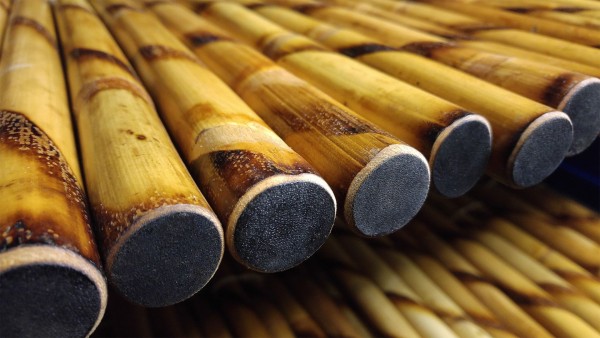Proper sticks are essential for the training of Eskrima, Arnis and Kali. The exact requirements vary slightly in the various styles. Your trainer can advise you which poles you need for training your specific system. Here we offer you some basic information for your stock purchase.
The most important material: rattan
Rattan sticks are usually used in stick fighting training. They are strong and at the same time flexible. The term rattan comes from the Malaysian rotan. The material is also called Manila or Manau. The big upside of rattan is that it won't splinter. After a while, Eskrima sticks wear out and they start to fray. But they won't break like broom sticks made of beech or ash wood. That's why there are no fragments flying around. The risk of injury is reduced considerably.
Although it looks like this, rattan is actually not wood at all, but a palm tree. The raw material is obtained from the rattan palm, of which there are numerous varieties. The shoots of some species can grow up to 100 meters long. The rattan fibres are used, among other things, as braiding material for baskets and chairs. Rattan is sometimes confused with bamboo. Unlike bamboo, however, it is not hollow - and therefore tougher. Bamboo sticks are not suitable for training Escrima, Arnis and Kali.
Length, diameter and weight of the sticks
The ideal length of the stick depends on the length of the athlete's arm. There is a simple rule of thumb: the stick should be at least as long as your own arm. For most people this is between 60 and 80 centimeters. The sticks should be neither too thick nor too thin, otherwise they can be difficult to hold. When the hand surrounds the stick, there must be no more than a narrow gap between fingers and ball of the hand, otherwise the stick is too thick. However, if your fingers squeeze into the ball, the stick is too narrow.
Even if you might suspect that: A thick stick is not always heavier than a thin one. The rattan sticks have a different density. For beginners, light sticks are the best way to learn the techniques easily. In training, a stick is usually sufficient at the beginning to carry out the most important exercises. Nevertheless, it is better to buy two that fit together. Sooner or later you will need the second one in training anyway, for example to train Sinawali-Drills.
Other materials: hardwood and plastic
Rattan is also used for another reason: Its fibre structure absorbs part of the impact energy when the sticks hit each other. In regular training, this protects the wrists. Heavy sticks made of less flexible materials such as hardwood or plastic do not have this advantage. Nevertheless, such sticks are used by experienced stick fighters in solo training. In that case they won't collide with other sticks. The additional weight can be useful to train the strength of the strike or improve whirling techniques.
In conclusion, it is important that the user feels comfortable with the stick. The personal feeling should not be ignored, because discomfort often has a cause. The stick must be well placed in the hand and can be guided without much effort. If you have any further questions or would like to know which type of stick suits your style of training, please feel free to contact our team. Fightingsticks will advise you by email or telephone.
Did you like this article? Follow Fightingsticks on Facebook and Pinterest.

